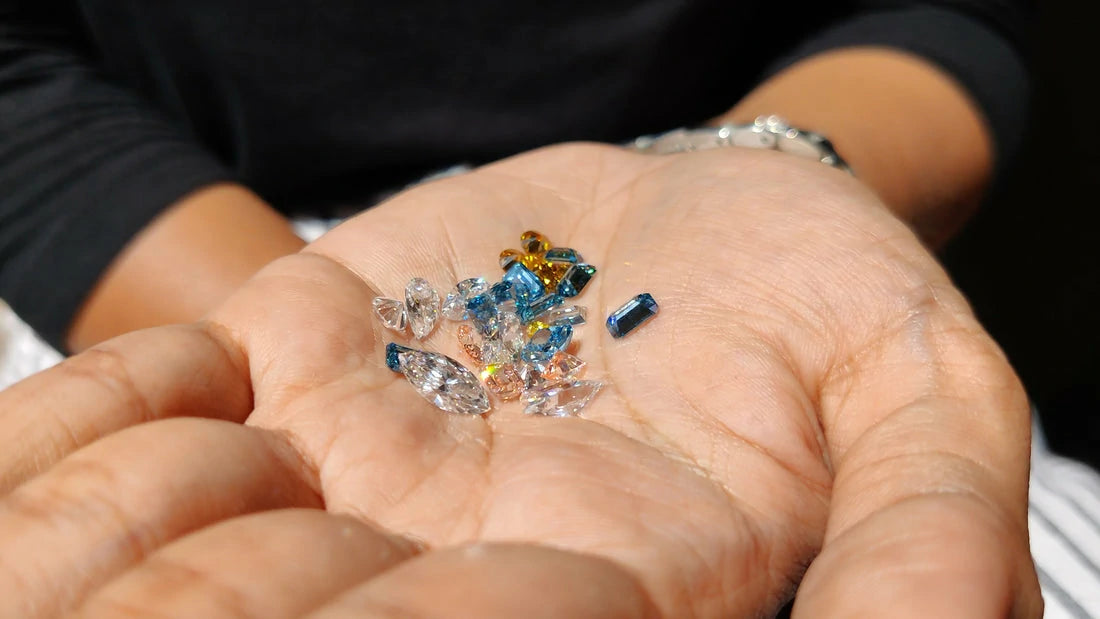Understanding Diamonds from Every Angle
Discover the Science Behind Diamonds: In-depth Details You Need to Know.



More than a billion years ago, deep within the Earth, carbon atoms joined together under intense heat and pressure, forming what we now know as diamonds—the toughest natural mineral on Earth.
After spending millions of years hidden deep underground, diamonds finally made their way to the surface through volcanic eruptions. The first discovery of diamonds dates back to ancient India in the 4th Century Before Christ. Since then, these dazzling gems have captured the hearts of people worldwide, remaining one of the most sought-after treasures.
At AARA, we cherish the beauty and wonder of diamonds. Join us in celebrating these extraordinary gems and their timeless allure.


Lab-grown diamonds also referred to as man-made or cultured diamonds are created in carefully controlled laboratory settings. These diamonds are formed using cutting-edge technology that replicates the natural conditions in which diamonds develop beneath the Earth's surface.
Instead of being mined from the earth, lab-grown diamonds are produced by arranging carbon atoms in the same crystal structure as natural diamonds. This process results in diamonds that possess identical optical and chemical properties to those found in nature. In essence, lab-grown diamonds offer a sustainable and ethical alternative to traditional mined diamonds.

Lab-grown diamonds originate from minuscule carbon seeds extracted from existing diamonds. Scientists employ advanced techniques, either through extreme pressure and heat or a specialized deposition method known as chemical vapor deposition (CVD), to replicate the natural diamond formation process.
Over a period of six to ten weeks, a rough diamond is cultivated. Subsequently, it undergoes meticulous cutting, polishing, and setting to become a finished piece of lab-grown diamond jewelry, such as earrings, necklaces, or bracelets.
There are two primary methodologies for creating lab-grown diamonds:
1. High Pressure High Temperature (HPHT): This method emulates the natural conditions found deep within the Earth's mantle. A sizable machine subjects a specified amount of carbon material to crushing pressures exceeding 870,000 pounds per square inch, along with extreme temperatures ranging from 1300 to 1600 degrees Celsius.
2. Chemical Vapor Deposition (CVD): In CVD, a seed diamond is placed within a small vacuum chamber filled with heated hydrogen and carbon-containing gases. At a particular temperature, these gas molecules disintegrate, resulting in layers of crystallized carbon forming around the seed, gradually enlarging the diamond. Some lab-grown diamonds produced via CVD may undergo additional pressure and heat treatment post-growth.
Distinguishing between natural diamonds and lab-grown diamonds cultivated through HPHT or CVD methods is virtually impossible for the naked eye. Only through the analysis of identifying markers caused by the growth conditions can scientists differentiate between them.


To the naked eye, distinguishing between a lab-grown and a natural diamond is nearly impossible—they share identical appearances. The sole discernible contrast lies in their origins: one originates from deep within the Earth, while the other is cultivated in a controlled laboratory environment.
Our lab-grown diamonds boast identical physical, chemical, and optical properties as their natural counterparts, showcasing the same brilliance, sparkle, and fire. While lab-created diamonds may contain trace elements that differ from natural diamonds, these variations have no impact on the diamond's visual appearance. The differentiation between lab-grown and natural diamonds necessitates specialized equipment and testing procedures.



Lab-grown diamonds stand as an exceptional alternative to mined diamonds, offering a host of advantages:
1. Physical Identically: Lab-grown diamonds mirror natural diamonds in appearance and composition, ensuring indistinguishable beauty.
2. Responsible Sourcing: Sourced responsibly, lab-grown diamonds contribute to ethical and sustainable practices in the industry.
3. Cost-Effectiveness: Offering greater affordability compared to mined diamonds, lab-grown diamonds provide an accessible option without compromising on quality.
4. Variety of Colors: Lab-grown diamonds can be produced in rare and unique colors not commonly found in nature, enabling the creation of distinctive and sought-after pieces.
5. Tractable Origin: With tractable origin sources, we can ensure that our diamonds come from reputable places, free from exploitation of workers or communities.
6. Meet Demand Responsibly: Utilizing HPHT and CVD methods, lab-grown diamonds enable us to meet demand efficiently without compromising quality or resorting to harmful practices.
At AARA, we embrace the benefits of lab-grown diamonds, offering you exquisite jewelry options that align with your values and desires.

Discover the diverse world of lab-grown diamonds at AARA, where we offer a range of options:
1. Colorless Ranges: Our lab-created diamonds come in various colorless ranges, ensuring you find the perfect shade for your preference.
2. Fancy Colors: Experience the rarity of fancy colored lab-created diamonds, including vivid yellows, blues, and pinks. These hues, formed with specific trace elements during growth, offer exquisite beauty at affordable prices compared to their natural counterparts.


Lab-grown diamonds undergo the same rigorous certification process as natural diamonds:
1. Certification Process: Qualified gemologists at esteemed institutions like the Gemological Institute of America (GIA) and the International Gemological Institute (IGI) meticulously evaluate each diamond's 4 C's (cut, color, clarity, and carat) to provide comprehensive reports, usually IGI certified.

Gain insights into diamond quality by exploring the 4 C's:
1. Cut: Refers to the proportion and arrangement of facets determining a diamond's brilliance. Grades range from Excellent to Poor.
2. Color: Describes the absence of color within a diamond, rated from D (colorless) to Z. Diamonds beyond this range are considered 'fancy colored.'
3. Clarity: Indicates the presence of internal inclusions and surface blemishes, graded from Internally Flawless to Included.
4. Carat: Measures a diamond's weight, not its size, with one carat roughly equaling the weight of a paperclip.


We prioritize sustainability by digitally delivering certifications with your purchase:
1. Certification Process: Each diamond receives a unique laser inscription correlating with its certification number, ensuring authenticity and quality verification.
2. Digital Delivery: Enjoy eco-friendly practices with digital certifications, reducing paper use, packaging size, and shipping emissions, thereby minimizing our carbon footprint.
At AARA, we strive to provide accessible, sustainable, and exquisite lab-grown diamonds that meet your needs and values.

Discover the beauty of diamond shapes at AARA:
1. Round: The most popular shape, known for its timeless elegance.
2. Fancy Shapes: Includes emerald, marquise, oval, and more, offering unique and distinctive outlines.


Explore the durability of diamonds:
1. Hardest Mineral: Diamond ranks at the highest level (10) on the Mohs scale, signifying unparalleled hardness.
2. Resistance to Scratching: With unmatched scratch resistance, diamonds are ideal for everyday wear and are perfect for center stones in jewelry and engagement rings.

Understand the unique phenomenon of diamond fluorescence:
1. UV Reaction: Fluorescence refers to a diamond's reaction to UV light, often emitting a blue or yellow glow.
2. Invisible Effect: While noticeable under UV light, fluorescence does not affect the appearance or structural integrity of the diamond under regular lighting.
Fluorescence is not a grading factor like the GIA 4Cs (color, clarity, cut, and carat weight), but it is an identifying characteristic. GIA Diamond Grading Reports and Diamond Dossiers describe a diamond’s fluorescence by its intensity under long-wave UV light (None, Faint, Medium, Strong and Very Strong). If the fluorescence is Medium, Strong, or Very Strong, the color of the fluorescence will be noted.

Explore the factors influencing diamond pricing:
1. Rarity and Quality: Diamonds with higher grades in cut, color, clarity, and carat weight are rarer and therefore more expensive.
2. Lab Grown Diamonds: Offered at a lower price point compared to natural diamonds, reflecting their availability and sourcing process.

Some diamonds are believed to be over 3 billion years old, making them among the oldest objects on Earth.
Diamonds aren't just found on Earth. Some white dwarf stars are thought to have a crystalline structure similar to diamonds, with a core of crystallized carbon.
Diamonds are the hardest known natural substance on Earth. They score a perfect 10 on the Mohs scale of mineral hardness, meaning they can only be scratched by other diamonds.
Diamonds conduct heat exceptionally well. This property makes them useful in various industrial applications, including in cutting tools and heat sinks for electronic devices.

While most people think of diamonds as clear or colorless, they actually come in a range of colors including yellow, brown, blue, green, pink, and red. These fancy colored diamonds are rare and highly sought after.
The largest diamond ever discovered is the Cullinan Diamond, found in South Africa in 1905. It weighed an astounding 3,106 carats in its rough form. It was cut into several large diamonds, two of which are part of the British Crown Jewels.
Tiny diamonds have been discovered in meteorites that have fallen to Earth. These diamonds are thought to have formed in the intense pressure and heat of the impact when the meteorites collided with other objects in space.

Throughout history, diamonds have been prized and revered by various ancient cultures. They were believed to possess mystical powers and were often used as talismans or incorporated into jewelry worn by royalty and nobility.
The diamond mining process can be incredibly labor-intensive. While modern techniques involve heavy machinery, historically, diamonds were mined by hand using simple tools like picks and shovels.
With advancements in technology, scientists can now create synthetic diamonds that are virtually identical to natural diamonds in terms of their chemical composition and physical properties. These lab-grown diamonds are increasingly popular for both industrial and jewelry purposes.
